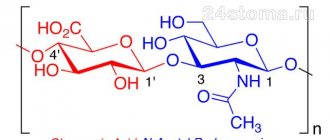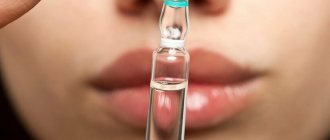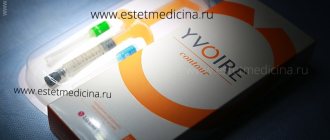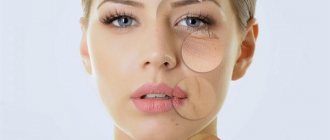Stoparthrosis
> Treatment methods
> Hyaluronic acid injection: pros and cons
Orthopedist
Litvinenko A. S.
January 10, 2022 20623
The insidiousness of joint arthrosis is that the patient begins to feel discomfort and pain, already having at least stage 2 of this disease. Disruption of the self-healing process of cartilage tissue leads to increased friction and destruction of cartilage. Modern medicine is constantly evolving, and today at the Stoparthrosis clinic patients can undergo an innovative course of therapy with intra-articular injections of hyaluronic acid. However, many are interested in the answer to the question of what are the pros and cons of hyaluronic acid injections. Let's figure it out.
Treatment with us is profitable!
- 20 years of experience
in treating diseases of the joints and spine - All in 1 day
— diagnostics, consultation and we will begin treatment
- Doctor's appointment 0 RUB! until January 20!
when treated with us - PROMOTION
Sign up for treatment
- 20 years of experience
in treating diseases of the joints and spine - All in 1 day
— diagnostics, consultation and we will begin treatment
- Doctor's appointment 0 RUB! until January 20!
when treated with us - PROMOTION
Sign up for treatment
Old price:
duration
— a course of treatment
Advantages of injections
Many patients with arthrosis suffer from severe pain and lameness; they fall out of a normal and active life for a long time. They try to take expensive medications that help restore cartilage tissue. However, even the most advanced and effective pills are slow to act. Therefore, advanced hyaluronic acid injections have been developed, the pros and cons of which there are many qualified opinions.
An important advantage in favor of intra-articular injections is their high efficiency, as well as the absence of adverse reactions and a quick and direct effect on the affected joint. For many patients, they have become a panacea in the fight against arthrosis. Hyaluronic acid injections help:
- pain reduction;
- improving cartilage nutrition;
- increasing joint mobility;
- production of own synovial fluid;
- slowing down degenerative processes.
Intra-articular injections should be performed after examination and consultation with a doctor by experienced specialists.
Sign up for treatment
Injections of hyaluronic acid into the joint
If you feel stiffness in your movements in the morning or severe pain in the joint, you should urgently see a doctor who will conduct an examination. Treatment in this case is necessary. At home, it is better not to experiment, but to immediately seek help from specialists.
It is important to understand that arthrosis cannot be completely cured, since the disease is irreversible. You can only slow down its development.
Hyaluronic acid injections are considered one of the most effective methods, and this has been repeatedly proven through many clinical studies.
How does this treatment affect the joints?
Hyaluronic acid is important for human organs because it is a component of them. Thanks to it, they are flexible, but at the same time quite durable. There is approximately 15 g of acid in our body, and, interestingly, every day one third of it is reconstructed.
In older people, the number of cells that can participate in the synthesis of hyaluronic acid often decreases. Due to its lack in the synovial fluid, tissue thinning occurs and wrinkles appear. This can lead to a number of diseases, for example, signs of deforming arthrosis of the joints will appear.
Hyaluronic acid acts as a conductor. Hyaline cartilage covers the articular surfaces of the joints; there are no blood vessels in this place; they are replaced by synovial fluid. Thus, it carries out all metabolic processes. The acid in the synovial fluid enters the middle of the cartilage, thereby reducing the friction force between other articular surfaces of the joint. This is what protects the joint from destruction and injury.
There is very little fluid in the joint, and with the development of various diseases, such as arthrosis, it can completely disappear from the cartilage cavity, in which case it is very easy to damage. The consequences can be different, for example, degenerative changes in the knee, severe pain or joint deformation. In this situation, it may lose its functions.
To prevent this from happening, the joint needs to be “nourished” using various methods. Injections directly into the joint are also called liquid prosthesis. Injecting hyaluronic acid into the knee will help increase its concentration in the joint, it will take on the functions of the lacking synovial fluid, promote the removal of unnecessary and toxic metabolic products, increase the mobility of the knee, and help eliminate pain in people suffering from arthrosis.
Why injections?
There are many different methods for providing acid to joints:
- ointments and gels;
- capsules or tablets;
- solutions for intra-articular injections.
Why is the latter method the most effective and popular among doctors?
Firstly, the medicine does not make its way through the digestive system, which is why most of it is destroyed, but immediately gets to the right place in maximum concentration.
Secondly, this method has been proven to be the most effective; the effect in other dosage forms has not been scientifically studied.
When is it better to start a course of treatment, the most effective period
Hyaluronic acid can be used at all stages. Of course, the greatest effect will be in the first and second stages of a disease such as knee arthrosis
, when the cartilage is not yet completely destroyed and there is something to restore. At the third stage of the disease, this is not effective, there will only be a short-term effect, because the cartilage tissue is no longer there and there is nothing to restore, in this case the patient can only be helped by surgical intervention, namely knee replacement.
Contraindications and side effects
It is prohibited to administer the medicine in the following cases:
- the patient is allergic to the drug;
- the integrity of the skin at the injection site is compromised;
- there is a rash;
- if there is an active inflammatory process;
- childhood and pregnancy;
- in case of acute infectious disease;
- if you have blood diseases;
- elevated temperature;
- the presence of a mental illness.
Injections with hyaluronic acid are usually easily accepted by the body, provided that the procedure is performed correctly. But sometimes complications and side effects appear:
- pain in soft tissues at the injection site due to damage from the needle;
- allergic reaction;
- feeling of itching, burning, swelling at the injection site;
- development of hemarthrosis due to bleeding.
Features of the use of solutions for intra-articular injections
Need to remember! All preparations with hyaluronic acid are quickly destroyed in the joint if there is an inflammatory process. Therefore, the injection is ineffective in case of exacerbation of arthrosis with signs of reactive synovitis. Injections should be given only in the remission stage of gonarthrosis.
From all of the above, we can conclude that it is impossible to quickly get rid of pain and inflammation in this way, but a course of injections will greatly improve the function of the joint, slow down the progression of arthrosis and reduce the number of possible pathologies, which will significantly alleviate the patient’s condition. It is important to understand that injections with hyaluronic acid work for the long term, and not for an immediate result.
Clinical studies have shown that the administration of the drug helps to delay the necessary surgery, and often avoid it.
If the injections are performed correctly, they are painless and are not accompanied by side effects, but you must follow all the doctor’s recommendations.
The course consists of 3-4 injections into each joint, the minimum interval between injections is 1-2 weeks.
You can repeat the course only after 1-1.5 years. Author: K.M.N., Academician of the Russian Academy of Medical Sciences M.A. Bobyr
Hyaluronic acid injections
Hyaluronic acid injections
If you choose the most popular cosmetic procedure, botulinum therapy will deservedly take first place, which allows you to successfully resist the signs of aging in the form of hyperkinetic wrinkles. Hyaluronic acid injections will take second place, but if you combine all the procedures that use this amazing organic compound, HA injections can compete with the famous Botox!
In this material we will consider the areas of application of hyaluronic acid in modern cosmetology. Let's talk about the procedures in which it is used, indications for its use, advantages, capabilities and disadvantages of existing techniques. Questions regarding recovery after the session and possible side effects will also be addressed.
Areas of use
Since hyaluronic acid injections are used very widely, it is appropriate to divide all indications for use into two large groups. The first includes anti-aging cosmetic procedures that are aimed at eliminating the signs of aging or preventing them. Secondly, plastic cosmetology procedures that change facial features and improve the patient’s appearance through targeted modeling of certain areas.
Anti-aging procedures: mechanism of action of HA
Popular anti-aging procedures with hyaluronic acid include biorevitalization, bioreparation, and mesotherapy. In European countries, biorevitalization is considered one of the areas of mesotherapy, but in domestic cosmetology it is separated into an independent procedure. As for bioreparation, it is considered one of the areas of biorevitalization.
But let’s not complicate the publication with subtle nuances regarding terminology and formulations; let’s dwell on the mechanism of action of hyaluronic acid. The secret to the effectiveness of this organic compound in rejuvenation programs is simple. Hyaluronic acid is a natural component of the dermis, which is responsible for its elastic properties, tone, moisture, turgor, and ability to withstand external influences.
In youth and adolescence, the skin is rich in hyaluronic acid. Fibroblasts, skin cells that synthesize elements that form the intercellular matrix, produce HA in sufficient quantities. The rate of synthesis of molecules is faster than the rate of their destruction, and therefore, as a rule, young girls do not have skin problems. At least those problems that are associated with age-related changes - wrinkles, deformation of the oval of the face, increased microrelief and decreased elasticity of the skin.
With age, the rate of formation of new HA molecules slows down, and the rate of degradation of this organic polymer, on the contrary, accelerates. The concentration of natural hyaluronic acid in the dermis decreases. A direct consequence of this is a deterioration in skin hydration, since one HA molecule holds about 500 water molecules. Not only moisture content decreases, but the elastic properties of the dermis, its elasticity and strength deteriorate.
Injections of hyaluronic acid help restore the original concentration of this polysaccharide in the middle layers of the dermis. Concentration typical for young and young adults. In cosmetology, HA of synthetic origin is used, obtained by bacterial synthesis and genetic engineering, but its properties are identical to natural hyaluronic acid.
Biorevitalization
In biorevitalization, the main component of the drug (biorevitalizant) is unstabilized HA. Immediately after the procedure, it saturates the facial skin with moisture and also has a stimulating effect on cellular elements. Under the influence of hyaluronic acid injections, the metabolic activity of fibroblasts increases. They begin to more actively synthesize molecules of elastin, collagen and other components of the intercellular matrix. The proliferative activity of stem cells increases, which leads to the replenishment of the cell pool with young fibroblasts, which, unlike old cells, are at the beginning of the life cycle.
In addition to hyaluronic acid, the biorevitalizant contains additional components. Which ones exactly depend on the type of drug. Many manufacturers include peptides, embryonic and platelet growth factors, vitamins, and amino acids. The complex of biologically active substances has a synergistic effect and doubles the rejuvenating effect of the procedure.
Mesotherapy
Mesotherapy courses use drugs with a slightly different composition. In addition to hyaluronic acid, they contain a large number of other components. Among others, meso-cocktails may include plant extracts, homeopathic remedies, microelements, peptide molecules, growth factors, biostimulants, antioxidants and vitamins.
Mesotherapy is used both in rejuvenation programs and to improve the condition of problem skin.
If we draw a conditional line between biorevitalization and mesotherapy, then the first technique is intended exclusively for rejuvenation, the second - for rejuvenation, prevention of aging, as well as for the correction of certain defects and various aesthetic problems not related to involutional processes. Make an appointment








